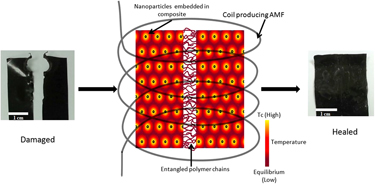Crossref Citations
This article has been cited by the following publications. This list is generated based on data provided by
Crossref.
Ahmed, Anansa S.
and
Ramanujan, R. V.
2015.
Magnetic Field Triggered Multicycle Damage Sensing and Self Healing.
Scientific Reports,
Vol. 5,
Issue. 1,
Ahmed, Anansa S.
and
Ramanujan, Raju V.
2015.
Hysteretic Buckling for Actuation of Magnet–Polymer Composites.
Macromolecular Chemistry and Physics,
Vol. 216,
Issue. 15,
p.
1594.
Feng, Xian Qi
Zhang, Gong Zheng
Bai, Quan Ming
Jiang, Hao Yang
Xu, Bo
and
Li, Huan Jun
2016.
High Strength Self‐Healing Magnetic Elastomers With Shape Memory Effect.
Macromolecular Materials and Engineering,
Vol. 301,
Issue. 2,
p.
125.
Amaral, Adérito J. R.
and
Pasparakis, George
2017.
Stimuli responsive self-healing polymers: gels, elastomers and membranes.
Polymer Chemistry,
Vol. 8,
Issue. 42,
p.
6464.
Ogliani, E.
Yu, L.
Javakhishvili, I.
and
Skov, A. L.
2018.
A thermo-reversible silicone elastomer with remotely controlled self-healing.
RSC Advances,
Vol. 8,
Issue. 15,
p.
8285.
Panigrahi, Ritwik
Oh, Hyun‐Suk
Sharma, Vinay
Lee, Kai Wei Kelvin
Rice, Scott A
Cohn, Daniel
and
Ramanujan, Raju V
2019.
Remote control of biofouling by heating PDMS/MnZn ferrite nanocomposites with an alternating magnetic field.
Journal of Chemical Technology & Biotechnology,
Vol. 94,
Issue. 8,
p.
2713.
Guo, Ting
Dou, Fengxiao
Lin, Mei
Huang, Junxing
Zhou, Chenglin
Zhang, Jun
Yu, Hong
Jiang, Xingmao
Ye, Jun
Shi, Yujuan
Xiao, Yanhong
Bian, Xuefeng
Feng, Xiaoqian
and
Xu, Ning
2019.
Biological Characteristics and Carrier Functions of Pegylated Manganese Zinc Ferrite Nanoparticles.
Journal of Nanomaterials,
Vol. 2019,
Issue. ,
p.
1.
Moriceau, Julien
Houizot, Patrick
Pasturel, Mathieu
Guizouarn, Thierry
and
Rouxel, Tanguy
2019.
A magnetic glass matrix (ZnO-BaO-B2O3) particulate (Fe3O4) nanocomposite obtained by SPS.
Journal of Non-Crystalline Solids,
Vol. 514,
Issue. ,
p.
116.
Cohn, Daniel
Sloutski, Aaron
Elyashiv, Ariel
Varma, Vijaykumar B.
and
Ramanujan, Raju
2019.
In Situ Generated Medical Devices.
Advanced Healthcare Materials,
Vol. 8,
Issue. 8,
Zhao, Bowen
Li, Shaonan
Liao, Xinzhang
Li, Jihang
Ma, Wujun
Dong, Yanmao
Zhou, Xing
and
Liu, Yaqing
2019.
Synthesis and Properties of Magnetic Self‐Healing Polymers: An Effective Method for Improving Interface Compatibility of Doped Functional Polymers.
ChemNanoMat,
Vol. 5,
Issue. 5,
p.
642.
Gupta, Ranjeetkumar
Huo, Dehong
White, Maggie
Jha, Vineet
Stenning, Gavin B.G.
and
Pancholi, Ketan
2019.
Novel method of healing the fibre reinforced thermoplastic composite: A potential model for offshore applications.
Composites Communications,
Vol. 16,
Issue. ,
p.
67.
Panigrahi, Ritwik
Zarek, Matt
Sharma, Vinay
Cohn, Daniel
and
Ramanujan, Raju V.
2019.
Bio‐Inspired Multiple Cycle Healing and Damage Sensing in Elastomer–Magnet Nanocomposites.
Macromolecular Chemistry and Physics,
Vol. 220,
Issue. 17,
Muradyan, Hurik
Mozhdehi, Davoud
and
Guan, Zhibin
2020.
Self-healing magnetic nanocomposites with robust mechanical properties and high magnetic actuation potential prepared from commodity monomers via graft-from approach.
Polymer Chemistry,
Vol. 11,
Issue. 7,
p.
1292.
Chaudhary, Richa
Chaudhary, Varun
Ramanujan, Raju V.
and
Steele, Terry W.J.
2020.
Magnetocuring of temperature failsafe epoxy adhesives.
Applied Materials Today,
Vol. 21,
Issue. ,
p.
100824.
Cohn, Daniel
Zarek, Matt
Elyashiv, Ariel
Sbitan, Mostafa Abu
Sharma, Vinay
and
Ramanujan, R V
2021.
Remotely triggered morphing behavior of additively manufactured thermoset polymer-magnetic nanoparticle composite structures.
Smart Materials and Structures,
Vol. 30,
Issue. 4,
p.
045022.
Antony, G. Jerald Maria
Raja, S.
and
Aruna, S.T.
2021.
Self‐Healing Smart Materials and Allied Applications.
p.
361.
Ekeocha, James
Ellingford, Christopher
Pan, Min
Wemyss, Alan M.
Bowen, Christopher
and
Wan, Chaoying
2021.
Challenges and Opportunities of Self‐Healing Polymers and Devices for Extreme and Hostile Environments.
Advanced Materials,
Vol. 33,
Issue. 33,
Darwish, Mohamed S. A.
and
Al-Harbi, Laila M.
2021.
The Influence of Self-Heating Iron on the Thermal, Mechanical, and Swelling Properties of PDMS Composites for Organic Solvents Removal.
Polymers,
Vol. 13,
Issue. 23,
p.
4231.
Charles, Andrew D.M.
Rider, Andrew N.
Brown, Sonya A.
and
Wang, Chun H.
2021.
Multifunctional magneto-polymer matrix composites for electromagnetic interference suppression, sensors and actuators.
Progress in Materials Science,
Vol. 115,
Issue. ,
p.
100705.
Baig, Mirza Shahed
Haque, Mohammad Akiful
Konatham, Teja Kumar Reddy
Mohammad, Badrud Duza
Yahya, Barrawaz Aateka
Saffiruddin, Shaikh Sana
Siddiqui, Falak A.
and
Khan, Sharuk L.
2022.
Recent Advancements in Hyperthermia-Driven Controlled Drug Delivery
from Nanotherapeutics.
Recent Advances in Drug Delivery and Formulation,
Vol. 16,
Issue. 4,
p.
270.
